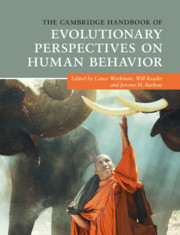Book contents
- The Cambridge Handbook of Evolutionary Perspectives on Human Behavior
- The Cambridge Handbook of Evolutionary Perspectives on Human Behavior
- Copyright page
- Dedication
- Contents
- Figures
- Tables
- Contributors
- Preface
- Acknowledgments
- Part I The Comparative Approach
- Part II Sociocultural Anthropology and Evolution
- Part III Evolution and Neuroscience
- Part IV Group Living
- Part V Evolution and Cognition
- Part VI Evolution and Development
- 21 Evolutionary Developmental Psychology
- 22 The Ontogeny and Evolution of Cooperation
- 23 Genomic Imprinting Is Critical for Understanding the Development and Adaptive Design of Psychological Mechanisms in Humans and Other Animals
- 24 Evolutionary Explanations for Bullying Behavior
- 25 Birth Order and Evolutionary Psychology
- Part VII Sexual Selection and Human Sex Differences
- Part VIII Abnormal Behavior and Evolutionary Psychopathology
- Part IX Applying Evolutionary Principles
- Part X Evolution and the Media
- Index
- References
25 - Birth Order and Evolutionary Psychology
from Part VI - Evolution and Development
Published online by Cambridge University Press: 02 March 2020
- The Cambridge Handbook of Evolutionary Perspectives on Human Behavior
- The Cambridge Handbook of Evolutionary Perspectives on Human Behavior
- Copyright page
- Dedication
- Contents
- Figures
- Tables
- Contributors
- Preface
- Acknowledgments
- Part I The Comparative Approach
- Part II Sociocultural Anthropology and Evolution
- Part III Evolution and Neuroscience
- Part IV Group Living
- Part V Evolution and Cognition
- Part VI Evolution and Development
- 21 Evolutionary Developmental Psychology
- 22 The Ontogeny and Evolution of Cooperation
- 23 Genomic Imprinting Is Critical for Understanding the Development and Adaptive Design of Psychological Mechanisms in Humans and Other Animals
- 24 Evolutionary Explanations for Bullying Behavior
- 25 Birth Order and Evolutionary Psychology
- Part VII Sexual Selection and Human Sex Differences
- Part VIII Abnormal Behavior and Evolutionary Psychopathology
- Part IX Applying Evolutionary Principles
- Part X Evolution and the Media
- Index
- References
Summary
Birth order has long been thought to have a lasting influence on people’s lives through its effects on social customs and by fostering individual differences in personality and social behavior. Historically, birth order has been linked with well-documented differences in professional opportunities and achievement, emigration patterns, likelihood of reproduction, mortality rates, inheritance practices, and the politics of royal succession (Altus, 1966; Boone, 1986; Bu, 2016; Duby, 1977; Galton, 1874; Herlihy, 1977; Hrdy & Judge, 1993; Sulloway, 1996). An analysis of birth order and the social customs in 39 non-Western societies found that firstborns generally receive more extensive birth ceremonies than do their younger siblings, are allotted special privileges, and, even in adulthood, exert authority over their brothers and sisters (Rosenblaat & Skoogberg, 1974). Additionally, firstborns in these 39 societies received a greater share of parental property than did laterborns.
- Type
- Chapter
- Information
- Publisher: Cambridge University PressPrint publication year: 2020



